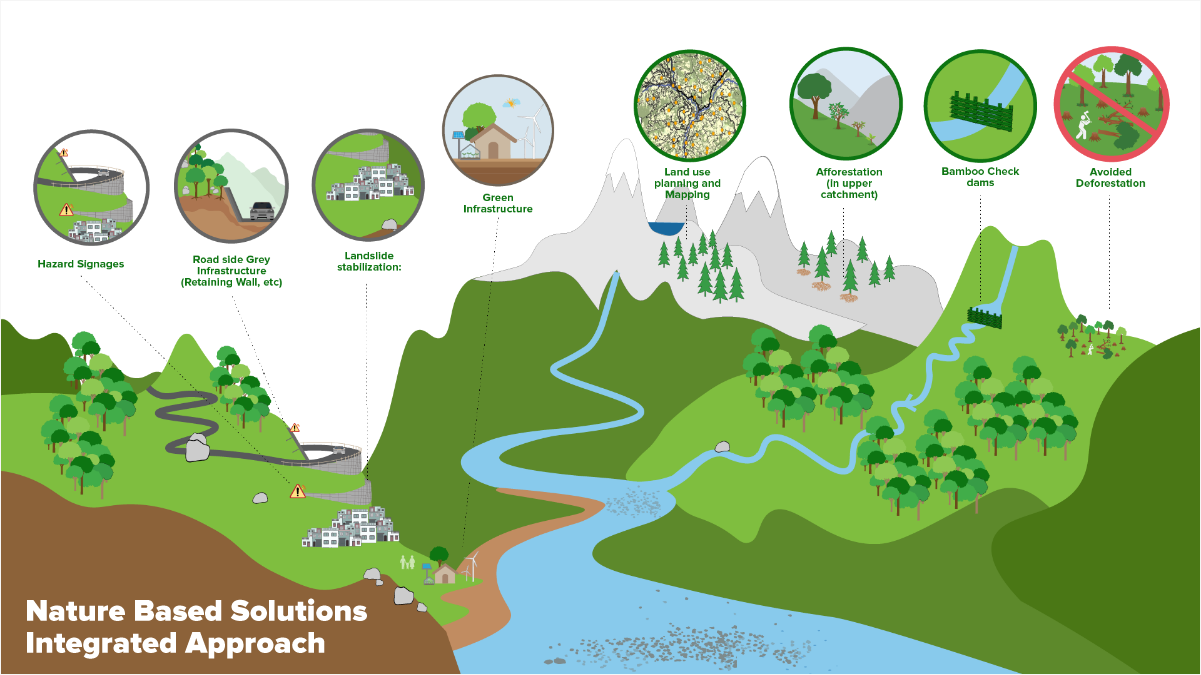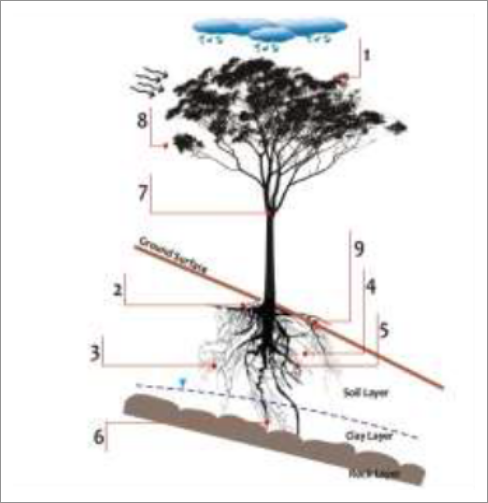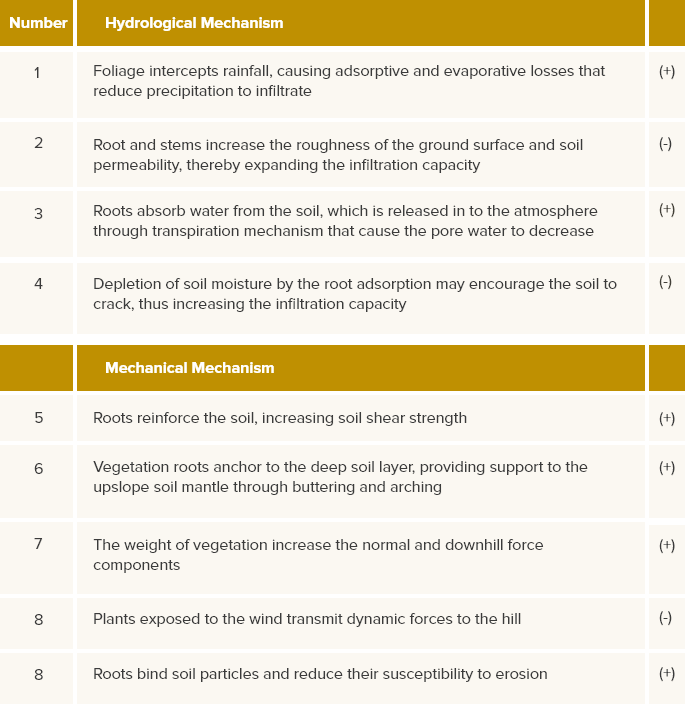Nature-Based Solutions
This section provides background information on NBS to inform the later discussion on how NBS can be integrated into landslide risk assessment and risk reduction. Nature-based solutions are gaining increased notice as a method of mitigating landslide and other disaster risk in a cost-effective manner with multiple co-benefits to people, livelihoods, the environment, and the climate. The table above highlighted how NBS can be used to address physical processes that contribute to landslide hazard. A key area of current research is understanding how smaller-scale NBS can be brought to larger landscape scales. One example of this is the recent H2020 project PHUSICOS, which seeks to demonstrate how NBS can be used for flood protection and landslide mitigation in large rural areas. A key aspect of NBS is the resilience these solutions build into natural systems and infrastructure at a landscape scale as they simultaneously contribute to risk reduction in specific landslide-prone areas. For example, at the same time that NBS can work to protect people and elements at risk within a specific landslide path, reduced erosion resulting from NBS can extend the life of development investments such as roads and hydropower facilities by reducing sediment loads in waterways. This is a key benefit of landslide risk reduction profiled in the Kaligandaki case study.
Key Terms for Nature-Based Solutions
Natural capital: defined by a recent World Bank/WRI report as “the planetary resources (e.g. plants, animals, air, water, soils, minerals) that sustain life and well-being. Natural capital underpins clean air, water and energy security, shelter, medicine, and more. Natural capital concepts are increasingly applied in national and corporate accounting to keep track of society’s dependence and impact on these vital resources.”
Nature-based solutions: defined by the IUCN as “…actions to protect, sustainably manage, and restore natural or modified ecosystems that address societal challenges effectively and adaptively, simultaneously providing human well-being and biodiversity benefits”.
Green infrastructure: defined by a recent World Bank/WRI report as infrastructure that “…intentionally and strategically preserves, enhances, or restores elements of a natural system, such as forests, agricultural land, floodplains, riparian areas, coastal forests (such as mangroves), among others, and combines them with gray infrastructure to produce more resilient and lower-cost services”.
Gray infrastructure: defined by a recent World Bank/WRI report as “… built structures and mechanical equipment, such as reservoirs, embankments, pipes, pumps, water treatment plants, and canals. These engineered solutions are embedded within watersheds or coastal ecosystems whose hydrological and environmental attributes profoundly afface the performance of gray infrastructure”.
Cost Effectiveness of NBS for Disaster Risk Reduction
While substantial evidence exists on the function of vegetative planting and other NBS methods for landslide risk, cost-effectiveness information is more limited. However, evidence suggests that disaster risk mitigation before an event occurs can be more cost effective than addressing social, environmental, and economic damage post-disaster, and the evidence for this, especially in developing countries, is an area of continued research (for example, see Shreve and Kelman 2014 who note that most cost-benefit analyses of disaster risk mitigation measures focus on flood, drought, and earthquakes). While not specific to landslide risk, some research has pointed to NBS as a cost-effective alternative to grey infrastructure. For example, WRI has estimated lower costs associated with green infrastructure development for filtering drinking water (US$1.5 billion for watershed conservation vs. US$8-10 billion to develop a new water filtration plans), reducing nutrient pollution (US$3.10 per pound of nitrogen reduced from forest buffers vs. US$8.56 per pound of nitrogen reduced from wastewater treatment plan upgrades) and treating wastewater (US$0.47 per 1,000 gallons of wastewater treated from wetlands vs. US$3.24 per 1,000 gallons of wastewater treated from a conventional wastewater treatment system) in the U.S. Increasing disaster risk and more frequent costly events may likely shift the balance in favor of proactive risk reduction measures in many cases. Shreve and Kelman 2014 also note the relative lack of information on the benefits of “ecosystem-based” disaster risk reduction, including measures such as reforestation and mangrove protection.
Evidence on the cost-effectiveness of NBS for landslide risk in growing but requires more research. Nehren and Mojica 2021 have conducted a global analysis of NBS for shallow landslide risk mitigation and note the need for additional research into the cost-effectiveness of these measures as compared to grey infrastructure. Singh 2010 provides evidence of bioengineering as a cost-effective solution with a high cost-benefit ratio, particularly when combined with traditional grey landslide risk reduction methods.
NBS Seek to Preserve the Ecosystem Services Nature Provides by Protecting and Restoring Natural Systems
Well-functioning ecosystems provide a host of critical ecosystem services that support the natural world and human society. These services include provisioning, regulating, supporting, and cultural services. Climate regulation has been recognized as a critical ecosystem service that nature can provide. A recent study estimates that natural climate solutions can provide 37% of costeffective CO2 mitigation needed through 2030 to have a reasonable probability of holding warming to 2 degrees Celsius. NBS focuses on using nature – and particularly vegetation and trees through avoided deforestation, afforestation and green infrastructure – to preserve and increase ecosystem services, thereby reducing natural disaster risks through mitigating flooding, erosion and sedimentation processes, and coastal erosion and sea level rise.
Video: Natural Capital & Ecosystem Services, Stanford Natural Capital Project
Forests and vegetation are the primary NBS for landslide risk management. Forests have hydrologic and mechanical characteristics that can increase slope stability and reduce shallow landslides through increasing soil strength and structure and reducing water yield. The effectiveness of forests to protect from shallow landslides depends on a number of factors, including hydrologic and soil conditions (e.g. soil moisture, evapotranspiration, soil type, soil thickness, precipitation patterns); topography (e.g. slope and slope stability); and the forest (e.g. species and health of trees, root system). The figure below shows the effect that trees/vegetation have on slope stability through both hydrological and mechanical mechanisms.
NBS can be implemented at various scales and for multiple sectors. NBS can be implemented at the landscape level, where whole watersheds or ecosystems are managed, protected, and/or restored to positively impact ecosystem services that deliver benefits to agricultural areas, hydropower facilities, waterways, cities, and coastal areas. At the other end of the spectrum, NBS can be implemented at the local level, either as green infrastructure for stormwater mitigation in an urban area, or green infrastructure installed above a road in hilly terrain to prevent landslides originating from higher elevations. Appropriate NBS mitigation measures may be scale dependent. To understand priority areas for NBS investment, development teams should conduct landscape-level assessment to identify areas external to the immediate project site that may significantly impact the project through landscape-scale natural processes (e.g. erosion and sedimentation). For example, on a single hillslope, NBS may not be effective in isolation, but could be implemented at the hillslope with other risk reduction measures, as well as in the surrounding areas that impact the hillslope.
Importantly, NBS have Multiple Important Co-benefits
In addition to mitigating disaster risk, NBS often have social, economic and environmental co-benefits. Community-based NBS implementation and management can increase community participation in natural resources management and can produce multiple income-generating streams. NBS can also increase carbon storage and sequestration, purify water, and protect and/or create habitat, leading to multiple biodiversity benefits. NBS increases climate resilience of communities and infrastructure because natural disaster risk is expected to increase with climate change.
Additional Resources
The World Bank’s Nature-Based Solutions Program
The World Bank’s Nature-Based Solutions Program, started in 2017, seeks to collate information on NBS used in Bank projects, provide guidance on integrating NBS into future projects, and to mainstream the use of NBS in future projects in DRM and water management. The program has thus far focused on coastal flooding and erosion, river flooding, and urban stormwater flooding. A growing number of Bank projects incorporate nature-based solutions for disaster risk reduction, such as forest-based landslide risk management in Sri Lanka, coastal flooding and erosion in Vietnam, and urban and river flooding in Senegal. The program estimates that since 2012, 76 DRM projects containing NBS have been approved to target many natural disaster risks, including coastal erosion; flooding (urban, rural and coastal); drought; and landslides. These projects have been implemented through a number of Bank Global Practice areas, including environment; social, urban, rural & resilience; agriculture; water; social protection & labor; and transport & ICT. A synopsis of the Bank’s NBS program is available here.
Bank resources on NBS. Key resources on NBS available through the World Bank’s activity are:
- Integrating Green and Gray: Creating Next Generation Infrastructure. Washington, DC: World Bank and World Resources Institute, 2019.
- Nature-Based Solutions for Disaster Risk Management. Washington, DC: World Bank, 2018.
- Implementing Nature-Based Flood Protection: Principles and Implementation Guidance. Washington, DC: World Bank, 2017.
- Managing Coasts with Natural Solutions: Guidelines for Measuring and Valuing the Coastal Protection Services of Mangroves and Coral Reefs. Washington, DC: World Bank Wealth Accounting and the Valuation of Ecosystem Services Partnership (WAVES), 2016.
- The Role of Green Infrastructure Solutions in Urban Flood Risk Management. Washington, DC: World Bank, 2016.
- Grow in Concert with Nature: Sustaining East Asia's Water Resources through Green Water Defense. A World Bank Study. Washington, DC: World Bank, 2012.
The Bank’s NBS Program has developed a searchable map encompassing projects with NBS components globally.
Integrating Green and Gray Infrastructure
A recent report from the World Bank and World Resources Institute, “World Bank 2019, Integrating Green and Gray: Creating Next Generation Infrastructure” shows how green infrastructure can combined with traditional “gray infrastructure” to provide next-generation solutions. As noted above, these integrated solutions can reinforce one another and increase system resilience as a whole. While this report does not discuss NBS/green infrastructure for landslide risk specifically (the focus is on coastal erosion and flooding, and management of river floods, urban stormwater, and drought), it offers a number of helpful overarching points on integrating NBS/green infrastructure with traditional solutions that can guide a more detailed discussion on NBS and landslide risk reduction.
- Green infrastructure is gaining momentum but is not yet mainstreamed.
- Research suggests that green infrastructure is more flexible and resilient to climate change than gray counterparts.
- GI requires service providers to engage with stakeholders and communities, which can be a lengthy and costly process.
- Enabling conditions/policies for GI financing and implementation are often limited.
- Lessons learned from previous green/gray integrated projects are limited; however, success in one area may not portend success in another due to the site-specific nature of GI effectiveness.
- Information on technical specifications, costs and benefits, and effectiveness at reducing risk is limited for green infrastructure as compared to gray. This information is necessary to pass, for example, ESF guidelines at the Bank.
- GI design and effectiveness are highly site-specific, and dependent on local social, environmental and economic conditions. GI may not be the most costeffective or technically appropriate solution in every situation.
- Risk assessment is a key element of understanding the role of GI in an integrated solution.
- Stakeholder engagement can identify upstream solutions where GI can be a more cost-effective solution. A famous example of this is New York City’s protection of upstream watersheds for its drinking water.
- Co-benefits of GI, which can be extensive, should be included in the project’s economic analysis.
Relevant Literature
USGS Introduction to Landslide Stabilization and Mitigation
IUCN Global Standards for NbS
United Nations Global Compact – Nature-Based Solutions to Address Climate Change
IPCC Climate Change and Land Report
Global Commission on Adaptation Report
Global Assessment Report on Biodiversity and Ecosystem Services


